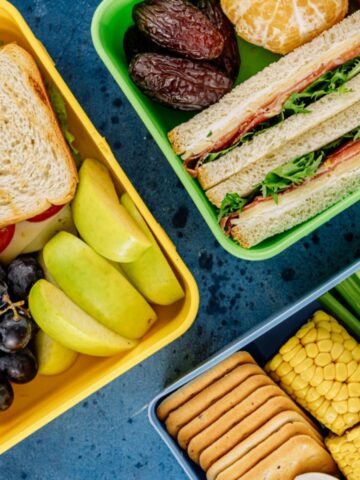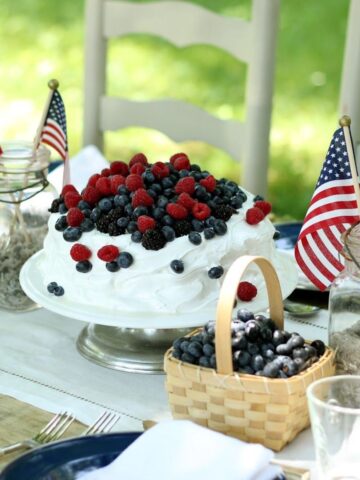There's nothing quite like the aroma and taste of freshly baked homemade bread. It's truly one of my all-time favorite foods. I’ve been making it the old fashioned way (by hand) for many years. There are machines that will mix it, knead it, bake it, and probably eat it for you. But feeling the dough at each stage of development is part of the unique pleasure I experience when I make my own bread.
If you’re fortunate enough to have developed an appreciation for good home cooked food, but you’re still buying your bread at the grocery store, you’re denying yourself one of the most rewarding experiences home cooking can offer. The happiness of bread baking in your oven, followed by the delight of sitting down to a slice of fresh homemade bread with you hands and a good cup of coffee, a glass of milk, or your favorite beer, ale or wine is hard to beat.
We take bread for granted. We go to the grocery store and buy those tasteless, spongy loaves and somehow convince ourselves that this is as good as it gets. Or maybe we think it’s the best we can afford or all we deserve. The truth is, good commercial bread is hard to find. Like many other foods, if you want it good, you have to make it yourself. However, good bread is not only easy to make, it’s fun.
I’m going to give you three good recipes. But first I’m going to give you a little technical information so you’ll know what part each ingredient plays in the making of the bread as well as what’s happening at each step along the way.
With this, you’ll be on your way to making the best bread you’ve ever tasted. If you’re a newcomer to bread baking, these recipes will give you a great opportunity to make an excellent loaf on your first try. But, even if you are an old kitchen hand, give these recipes a try. I think you’re going to like them.
The equipment :
First, let’s examine some of the equipment you’re going to need. Although bread can be baked in two ways free form and in loaf pans we’re going to use pans. There are several different sizes and each has a specific use. The most common, and the one we’ll be working with here, is 9”x5”x3”. This size pan will hold from 22 to 26 ounces of dough.
If you’ve read my earlier columns, you know I make big use of a food thermometer. When baking bread, the temperature of the liquids to be combined with the yeast must be measured. You’ll want a good food thermometer for this.
Liquid that's too hot will kill the yeast, but if it’s too cold, it will slow the yeast down and the bread won’t rise properly. A good bread knife is as important as a good bread pan or thermometer. The wrong knife will tear fresh bread apart instead of slicing it. Take my advice; buy a good bread knife with a serrated blade. You won’t regret it.
No matter how new or expensive your oven is, it’s quite possible that the temperature settings on it are not accurate. When baking bread it is important that the oven temperature be accurate. To check this, buy an oven thermometer. They’re not expensive. Set your oven to a medium temperature, like 300 degrees, and heat it with the thermometer in the middle of the oven.
Check the thermometer in about fifteen minutes. If the set temperature does not agree with the thermometer, either use the thermometer to determine oven temperatures or call a repairman and have your oven calibrated.
Bread is best when baked in an oven that produces a steady and evenly diffused heat. Most gas or electric ovens produce radiated heat which can produce hot and cool spots. You can compensate for this by turning your loaves around once or twice during baking. But there are two more reliable solutions.
One is to buy a baking stone and place it on the lowest rack in the oven. Better yet, buy a half dozen 5 ½” square unglazed quarry tiles from your local building supply store. Place these on the lowest rack in your oven. They are less expensive than a baking stone and work just as well. I have been using my quarry tiles for ten years with excellent results.
During the rising process the dough must be covered. A good cloth dish towel will do the job.
Finally, when mixing bread dough by hand, a good sturdy wooden spoon is worth having. Bread dough can get quite stiff before all the required flour is added and the spoon will make mixing easier.
The ingredients :
Now, let's briefly examine the ingredients you need to make bread dough and what part each plays.
First there’s the flour. Flour is the backbone of any bread. There are several flours available for bread white, whole wheat, barley, corn, oat, and rye flour to name a few. But we will use only the white and whole wheat here. Hard wheat bread flour and all purpose flour are the most common white flours used in bread. The hard wheat flour is used by professional bakers but is available at the supermarket. It has a high percentage of protein and gluten, which makes it a first choice for bread.
When the flour is mixed with water this protein is activated and makes the dough strong and elastic. A strong elastic dough will hold the gas generated by the yeast so the bread will rise. All purpose flour does not have as much gluten as bread flour and will not rise as reliably.
There are several types of whole wheat flour. There are stone ground and pumpernickel, which are coarse grinds, and graham which is finely ground. All whole wheat flour is made by grinding the whole kernel including the bran and the germ. (The germ is the sprouting section of the kernel and contains fat.)
There are several leavening agents used in baking. Yeast is one of the most important. Yeast cells feed on sugar in the bread mixture to produce carbon dioxide which is the reason the dough rises. You can find three varieties of yeast in the store dry granulated, fresh cake, and fast acting dry granulated. I’m going to recommend the use of dry granulated for these recipes because it is easy to use and stores well. “Proof” your yeast before you use it. P
roofing is done by mixing the yeast with some sugar and a little water that has been heated to between 110 and 115 degrees. Proofing lets you know if the yeast is active. In about 5 minutes a layer of foam should appear on top of the mixture. If you don’t get the foam, the yeast is not active and you must start again with fresh yeast.
Sugar, in the form of refined white sugar, honey, or molasses impart sweetness as well as flavor to bread. It also helps the crust to brown. Because it feeds the activity of the yeast, sugar in some form is included in most bread recipes. Salt accents the flavor of other ingredients and helps to control yeast activity. A lot of people, in baking bread, under salt. This doesn’t do the bread any good but if you feel compelled to do so for health reasons, go ahead.
Fat contributes tenderness to the loaf and lubricates the gluten, helping the dough to rise. Butter, margarine and lard contribute unique flavors to bread. My preference is margarine because it is low in cholesterol. However, salad or vegetable oil can be substituted in any recipe calling for melted butter, margarine, or lard, Many liquids are used in bread making, but milk is by far the most popular.
Milk contributes a velvety grain and browner crust to your bread. It also adds vital nutrients and additional flavor. I use non-fat dry milk because it has the qualities mentioned above without adding fat to the loaf. Measuring the flour, mixing the flour with the other ingredients, kneading the dough and rising (proofing) the dough are the four procedures that determine the success of your bread.
Flour does not need sifting when used for bread. When measuring flour for bread dough, use the “scoop and level” method. Scoop the flour from it’s container with the correct size measuring cup, then level the flour to the top of the cup with the straight side of a knife or spatula. This is how all of the flour was measured for the recipes in this column. Don’t tamp the flour down. Because flour is not consistent with moisture content, even with the same brand name, the recipe that takes six cups this week may only require five cups next week.
For this reason I have given only approximate measurements for bread flour in the recipes. Also, the assembly instructions call for only a portion of the bread flour to be added when first mixing it with other ingredients. The remainder can be added a little at a time during kneading. When you have added enough you’ll know by the feel of the dough.
Kneading :
Kneading is where you get the first indication of what sort of adjustments will benefit the recipe's outcome. If the dough feels too dry, it can be returned to the bowl, and a little more liquid can be added. The dough should be sticky when you first start kneading. This allows you to add flour a little at a time until the dough feels just right. Sufficient kneading is necessary to get proper rising of the dough. Kneading consists of three routine steps and one occasional "fun" step.
The routine steps are push, turn, and fold. The occasional fun step is called "slam." After sufficient mixing of the dough, sprinkle a little flour on the work surface to make it not sticky and remove the dough from the bowl to this area. Form the dough into a ball, adding a little more flour to the work surface to prevent sticking. Push down on the ball with the heels of your hands. Pull back on the dough, give it a quarter turn, and fold it.
Now repeat this for ten to fifteen minutes - push, turn, and fold. Every few minutes, pick up the dough and "slam" it down on the counter. The dough loves this treatment and will reward you with excellent bread. Kneading is complete when the dough no longer feels sticky and has developed an elastic texture.
To determine if kneading is complete, make an indent in the dough with your finger. If the indent springs back, you're done.
Proofing is when the yeast cells take over. This is a quiet period when the yeast does its act, and the dough rises. Proofing should be done in a well-oiled, straight-sided bowl, large and big enough to allow the dough to double in bulk without coming over the top. The dough has risen enough when it has doubled its bulk. Test this by making another indent in the dough. If the indent remains, the dough has risen enough.
Let’s Get to the Recipes!
1. Mixed Grain Bread
A hearty loaf made with oats, wheatena, and whole wheat flour nutty, rich, and satisfying.
2. Whole Wheat Bread
This wholesome, high-fiber loaf features molasses, honey, and whole wheat flour. Great for sandwiches or toast.
3. Classic White Bread
A soft, fluffy loaf perfect for everyday use. It’s kid-friendly and delicious with just butter.
Final Thoughts
Whether you're a bread-baking beginner or a seasoned pro, these three recipes offer something special. Once you start making bread at home, you may never go back to store-bought again. The satisfaction of baking your own loaves is as nourishing as the bread itself.
Explore these recipes and bring your kitchen to life with the smell of freshly baked bread.
For more homestyle recipes, tips, and wholesome inspiration, visit our homepage: FoodvLove.
FAQs
Whole wheat bread is one of the healthiest options. It’s high in fiber, nutrients, and keeps you fuller longer.
Yes, homemade bread typically contains fewer additives, preservatives, and sugars, making it a healthier choice.
Homemade bread lasts 3–4 days at room temperature. Store it in an airtight bag or container to keep it fresh.
Absolutely! Wrap it tightly in plastic and freeze for up to 3 months. Slice it first for easy defrosting.
Bread flour gives the best texture and rise, but you can also use all-purpose or whole wheat flour depending on your recipe.
Tap the bottom of the loaf if it sounds hollow, it’s done. You can also check with a thermometer; the center should be around 190°F to 200°F.





Leave a Reply